中国传统文化翻译解读
中国传统文化英语翻译教学教材

中国传统文化英语翻译1.香囊(scented sachet),古代也称“香袋”,通常是用布缝制或彩色丝线编织的袋子,里面塞满香草(aromatic herbs)。
香囊最初用来吸汗、驱虫和避邪。
香囊不仅有用,而且可作装饰品。
它们的形状和大小各异,有圆形、椭圆形和其他形状。
它们通常配有精致的图案,每个图案都象征着特别的含义。
例如,双鱼或成对蝴蝶图案象征男女之爱;莲花或牡丹花(peony flower)等图案象征女性;松树和仙鹤图案象征长寿;石榴(guava)图案象征很多孩子。
漂亮的香囊不仅是装饰品,而且含有丰富的文化和历史内涵。
翻译:Scented sachets, also called “fragrant bags” in ancient times, are bags usually sewed with cloth or weaved with multicolor silk threads and stuffed with aromatic herbs. The fragrant bags were originally used for absorbing sweat, repelling insects and warding off evils. Scented sachets are not only useful, but also ornamental. They come in different shapes and sizes, such as round, oval and many others. And they are normally decorated with elaborate patterns, with each pattern symbolizing a special meaning.For instance,a double-fish or double-butterfly pattern smybolizes the love between a man and a woman;patterns like lotus or peony flowers symbolize women;pine and crane patterns symbolize longevity and a guava pattern is the symbol of lots of children.A nice scented sachet is not just an ornament,but more of something that contains cultural and historical richness.2.中国民间艺术与中国哲学统一于“阴阳(yin-yang)生万物”这一理念。
中国传统文化英语版
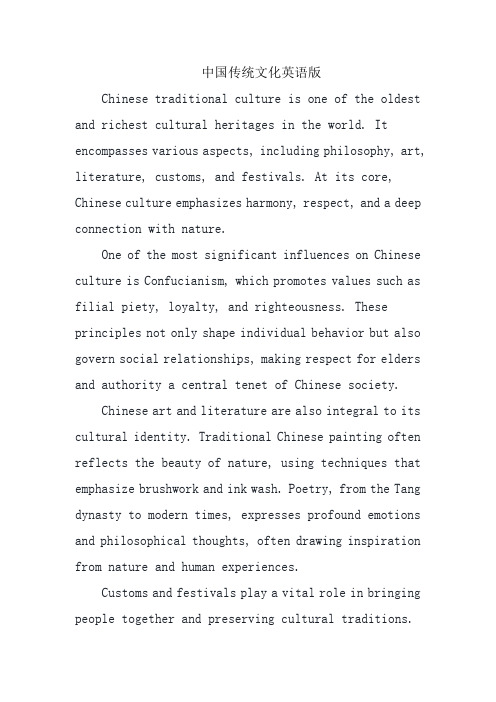
中国传统文化英语版Chinese traditional culture is one of the oldest and richest cultural heritages in the world. It encompasses various aspects, including philosophy, art, literature, customs, and festivals. At its core, Chinese culture emphasizes harmony, respect, and a deep connection with nature.One of the most significant influences on Chinese culture is Confucianism, which promotes values such as filial piety, loyalty, and righteousness. These principles not only shape individual behavior but also govern social relationships, making respect for elders and authority a central tenet of Chinese society.Chinese art and literature are also integral to its cultural identity. Traditional Chinese painting often reflects the beauty of nature, using techniques that emphasize brushwork and ink wash. Poetry, from the Tang dynasty to modern times, expresses profound emotions and philosophical thoughts, often drawing inspiration from nature and human experiences.Customs and festivals play a vital role in bringing people together and preserving cultural traditions.The Spring Festival (Chinese New Year) is perhaps the most celebrated holiday, symbolizing renewal and family reunification. During this time, families gather to share meals, exchange red envelopes, and partake in various customs to ward off evil spirits and bring good luck.Moreover, traditional Chinese medicine, with its holistic approach, emphasizes balance and harmony within the body. Practices such as acupuncture and herbal medicine are rooted in thousands of years of knowledge and continue to be relevant today.In conclusion, Chinese traditional culture is a treasure trove of wisdom and practices that have shaped the lives of millions. It teaches us the importance of harmony, respect for nature, and the value of community. Understanding and appreciating this culture not only enriches our lives but also fosters a deeper connection between people from different backgrounds.中文翻译:中华传统文化是世界上最古老、最丰富的文化遗产之一。
中国传统文化翻译
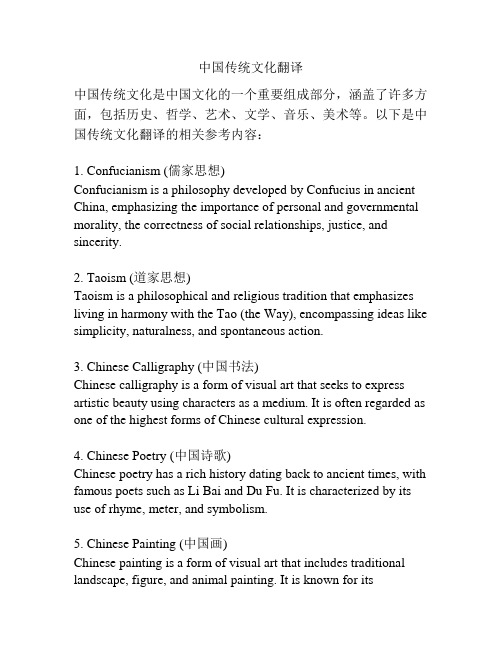
中国传统文化翻译中国传统文化是中国文化的一个重要组成部分,涵盖了许多方面,包括历史、哲学、艺术、文学、音乐、美术等。
以下是中国传统文化翻译的相关参考内容:1. Confucianism (儒家思想)Confucianism is a philosophy developed by Confucius in ancient China, emphasizing the importance of personal and governmental morality, the correctness of social relationships, justice, and sincerity.2. Taoism (道家思想)Taoism is a philosophical and religious tradition that emphasizes living in harmony with the Tao (the Way), encompassing ideas like simplicity, naturalness, and spontaneous action.3. Chinese Calligraphy (中国书法)Chinese calligraphy is a form of visual art that seeks to express artistic beauty using characters as a medium. It is often regarded as one of the highest forms of Chinese cultural expression.4. Chinese Poetry (中国诗歌)Chinese poetry has a rich history dating back to ancient times, with famous poets such as Li Bai and Du Fu. It is characterized by its use of rhyme, meter, and symbolism.5. Chinese Painting (中国画)Chinese painting is a form of visual art that includes traditional landscape, figure, and animal painting. It is known for itscombination of brushwork, ink-wash, and color, and tends to focus on capturing the essence or spirit of the subject matter.6. The Five Elements (五行)The Five Elements theory is a concept in Chinese philosophy that suggests that everything in the world is composed of five basic elements - wood, fire, earth, metal, and water. It is often used to describe the natural world and is also applied in traditional Chinese medicine and feng shui.7. Feng Shui (风水)Feng shui is a traditional Chinese practice that aims to arrange the environment in a way that is harmonious with nature and beneficial to its inhabitants. It involves the placement of objects and structures in a way that enhances the flow of "qi" (life force).8. Tea Culture (茶道)Tea culture is a traditional Chinese practice that originated in ancient China and has developed into a sophisticated art form. It involves the preparation, serving, and enjoyment of tea, as well as its social roles in China's history.9. Chinese Cuisine (中国菜)Chinese cuisine is a diverse culinary tradition that encompasses eight regional cuisines, such as Sichuan, Cantonese, and Shandong. It emphasizes the use of fresh ingredients, delicacy, and balance of flavors.10. Traditional Festivals (中国传统节日)Traditional festivals in China reflect cultural traditions and values,such as Spring Festival (Chinese New Year), Mid-Autumn Festival, and Dragon Boat Festival. They involve a variety of activities, such as family gatherings, eating special foods, and giving and receiving gifts.。
中华优秀传统文化英文解读unit1texta

中华优秀传统文化英文解读1. Introduction中华优秀传统文化是我国几千年来形成的丰富而深厚的文化遗产,它涵盖了我国人民对生活、社会、宇宙和人生的认知和积淀,是我国文化的精髓和灵魂。
本文将对中华优秀传统文化进行英文解读,以便更好地向世界展示我国独特的文化魅力。
2. ConfucianismConfucianism is a system of ethics and philosophy based on the teachings of Confucius, a Chinese philosopher who lived during the Spring and Autumn period. Confucianism emphasizes the importance of family, respect for elders, and the cultivation of virtue. It also promotes the idea of a harmonious society and the concept of 'ren', or benevolence, as the highest virtue. Confucianism has had a profound impact on Chinese society and has greatly influenced the social, political, and cultural norms in China.3. DaoismDaoism, also known as Taoism, is a philosophical and religious tradition that emphasizes living in harmony with the Dao, or the way of nature. It promotes the idea of non-action, or 'wu wei',and advocates for spontaneity, simplicity, and naturalness. Daoism also incorporates practices such as meditation, qigong, and T本人 Chi, which 本人m to cultivate the body, mind, and spirit in order to achieve a state of balance and harmony.4. Chinese CalligraphyChinese calligraphy is a highly esteemed art form that has been practiced for thousands of years. It is considered a reflection of the calligrapher's personality, emotions, and state of mind, and is often regarded as a form of meditation. Chinese calligraphy epasses various styles and techniques, such as seal script, clerical script, standard script, and cursive script, each with its own unique characteristics and aesthetic appeal.5. Chinese Traditional MedicineChinese traditional medicine, including acupuncture, herbal medicine, and qigong, is a holistic system of healthcare that has been practiced in China for over 2,000 years. It is based on the principles of Yin and Yang, the Five Elements, and the concept of Qi, or vital energy. Chinese traditional medicine 本人ms to restore the balance and harmony of the body, mind, and spirit in order to promote health and prevent disease.6. ConclusionIn conclusion, 中华优秀传统文化 epasses a diverse range of philosophical, artistic, and medical traditions that have shaped Chinese society and culture for millennia. By understanding and appreciating these cultural treasures, we can g本人n insight into the values, beliefs, and aspirations of the Chinese people, and foster greater mutual understanding and respect between different cultures in our increasingly interconnected world. Let us continue to cherish and preserve the richness and wisdom of 中华优秀传统文化 for the benefit of future generations.。
传统文化翻译重点梳理(带答案)
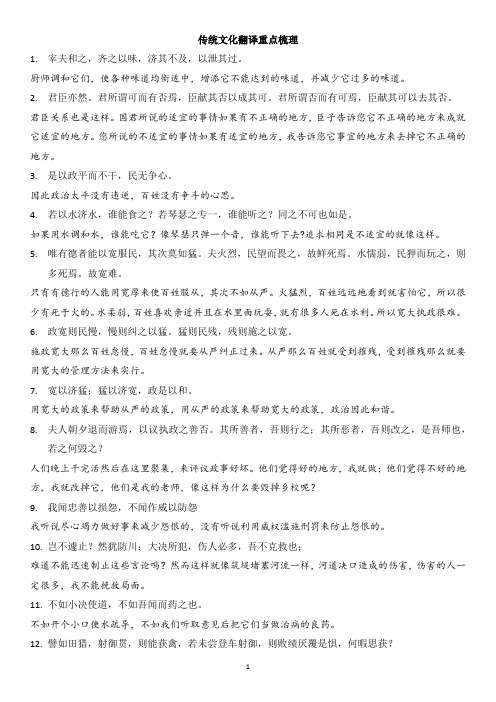
传统文化翻译重点梳理1.宰夫和之,齐之以味,济其不及,以泄其过。
厨师调和它们,使各种味道均衡适中,增添它不能达到的味道,并减少它过多的味道。
2.君臣亦然。
君所谓可而有否焉,臣献其否以成其可。
君所谓否而有可焉,臣献其可以去其否。
君臣关系也是这样。
国君所说的适宜的事情如果有不正确的地方,臣子告诉您它不正确的地方来成就它适宜的地方。
您所说的不适宜的事情如果有适宜的地方,我告诉您它事宜的地方来去掉它不正确的地方。
3.是以政平而不干,民无争心。
因此政治太平没有违逆,百姓没有争斗的心思。
4.若以水济水,谁能食之?若琴瑟之专一,谁能听之?同之不可也如是。
如果用水调和水,谁能吃它?像琴瑟只弹一个音,谁能听下去?追求相同是不适宜的就像这样。
5.唯有德者能以宽服民,其次莫如猛。
夫火烈,民望而畏之,故鲜死焉。
水懦弱,民狎而玩之,则多死焉。
故宽难。
只有有德行的人能用宽厚来使百姓服从,其次不如从严。
火猛烈,百姓远远地看到就害怕它,所以很少有死于火的。
水柔弱,百姓喜欢亲近并且在水里面玩耍,就有很多人死在水利。
所以宽大执政很难。
6.政宽则民慢,慢则纠之以猛。
猛则民残,残则施之以宽。
施政宽大那么百姓怠慢,百姓怠慢就要从严纠正过来。
从严那么百姓就受到摧残,受到摧残那么就要用宽大的管理方法来实行。
7.宽以济猛;猛以济宽,政是以和。
用宽大的政策来帮助从严的政策,用从严的政策来帮助宽大的政策,政治因此和谐。
8.夫人朝夕退而游焉,以议执政之善否。
其所善者,吾则行之;其所恶者,吾则改之,是吾师也,若之何毁之?人们晚上干完活然后在这里聚集,来评议政事好坏。
他们觉得好的地方,我就做;他们觉得不好的地方,我就改掉它,他们是我的老师,像这样为什么要毁掉乡校呢?9.我闻忠善以损怨,不闻作威以防怨我听说尽心竭力做好事来减少怨恨的,没有听说利用威权滥施刑罚来防止怨恨的。
10.岂不遽止?然犹防川:大决所犯,伤人必多,吾不克救也;难道不能迅速制止这些言论吗?然而这样就像筑堤堵塞河流一样,河道决口造成的伤害,伤害的人一定很多,我不能挽救局面。
中国文化英语教程unit3原文翻译(束定芳版)

中国文化英语教程unit3原文翻译(束定芳版)(原创实用版)目录1.介绍中国文化英语教程 Unit 3 的内容2.翻译束定芳版的 Unit 3 原文3.对原文进行详细解读正文中国文化英语教程是一本面向英语学习者的教材,旨在通过教授中国文化的知识,帮助学习者更好地理解和掌握英语。
本教程的 Unit 3 主题为“中国传统文化”,内容包括中国古代哲学、文学、艺术等方面。
本文将对束定芳版的 Unit 3 原文进行翻译,并详细解读原文内容。
【原文翻译】Unit 3: Chinese Traditional CultureLesson 1: Confucianism1.1 Confucius and His Ideas1.2 The Five Constant Virtues1.3 The Four Noble TruthsLesson 2: Taoism2.1 Lao Tzu and His Thoughts2.2 The Yin and Yang2.3 The Tao Te ChingLesson 3: Chinese Literature3.1 The Analects3.2 The I Ching3.3 Tang PoetryLesson 4: Chinese Art4.1 Calligraphy4.2 Painting4.3 SculptureLesson 5: Chinese Traditional Music5.1 The Qin5.2 The Erhu5.3 The Guqin【原文解读】本单元的主题是中国传统文化,共分为五个小节,分别是儒家、道家、中国文学、中国艺术和中国传统音乐。
第一节课是儒家,主要介绍了儒家学派的创始人孔子及其思想,以及儒家五常:仁、义、礼、智、信。
同时,还介绍了佛教的四谛:苦、集、灭、道。
第二节课是道家,讲述了道家学派的老子及其思想,包括道家的阴阳学说和《道德经》。
第三节课是中国文学,本节课选编了《论语》、《易经》和唐诗作为学习材料,以展示中国古代文学的魅力。
中国传统文化(中英文)
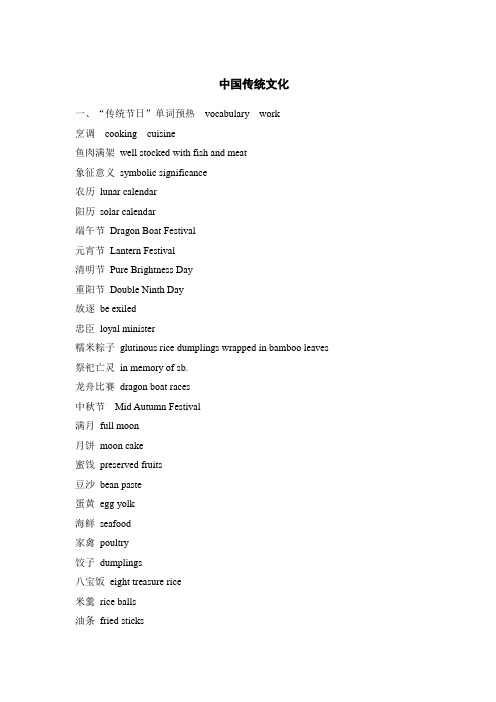
中国传统文化一、“传统节日”单词预热vocabulary work烹调cooking cuisine鱼肉满架well stocked with fish and meat象征意义symbolic significance农历lunar calendar阳历solar calendar端午节Dragon Boat Festival元宵节Lantern Festival清明节Pure Brightness Day重阳节Double Ninth Day放逐be exiled忠臣loyal minister糯米粽子glutinous rice dumplings wrapped in bamboo leaves 祭祀亡灵in memory of sb.龙舟比赛dragon boat races中秋节Mid Autumn Festival满月full moon月饼moon cake蜜饯preserved fruits豆沙bean paste蛋黄egg yolk海鲜seafood家禽poultry饺子dumplings八宝饭eight treasure rice米羹rice balls油条fried sticks麻花fried twisted stick炒面Chaomian叉烧包steamed bun with roast pork粥porridge芋头taro葱油饼pan-fried cake with sesame seeds and green onion有关春节的常用词放鞭炮let off firecrackers耍龙灯play the dragon lantern耍狮子play the lion dance拜年pay a new-year callChinese to English:1. 玉器是光辉灿烂的中华民族历史文化宝库中一枝异彩独放的奇葩。
中国玉器在新石器时代的河姆渡文化时期就开始出现。
7000年来一直延续不断,发展至今。
中国传统文化 翻译
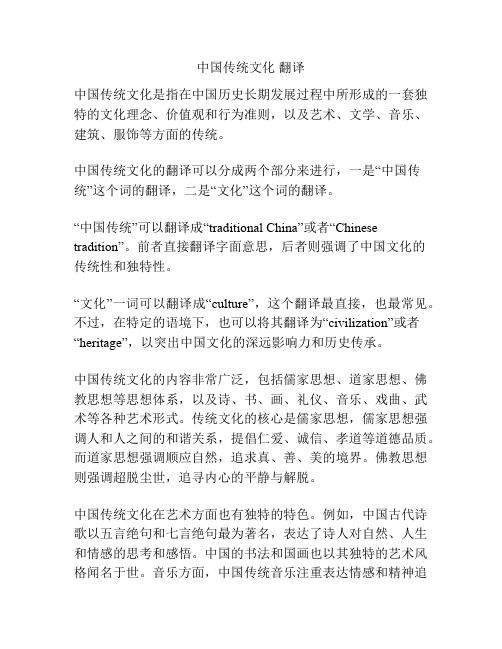
中国传统文化翻译中国传统文化是指在中国历史长期发展过程中所形成的一套独特的文化理念、价值观和行为准则,以及艺术、文学、音乐、建筑、服饰等方面的传统。
中国传统文化的翻译可以分成两个部分来进行,一是“中国传统”这个词的翻译,二是“文化”这个词的翻译。
“中国传统”可以翻译成“traditional China”或者“Chinese tradition”。
前者直接翻译字面意思,后者则强调了中国文化的传统性和独特性。
“文化”一词可以翻译成“culture”,这个翻译最直接,也最常见。
不过,在特定的语境下,也可以将其翻译为“civilization”或者“heritage”,以突出中国文化的深远影响力和历史传承。
中国传统文化的内容非常广泛,包括儒家思想、道家思想、佛教思想等思想体系,以及诗、书、画、礼仪、音乐、戏曲、武术等各种艺术形式。
传统文化的核心是儒家思想,儒家思想强调人和人之间的和谐关系,提倡仁爱、诚信、孝道等道德品质。
而道家思想强调顺应自然,追求真、善、美的境界。
佛教思想则强调超脱尘世,追寻内心的平静与解脱。
中国传统文化在艺术方面也有独特的特色。
例如,中国古代诗歌以五言绝句和七言绝句最为著名,表达了诗人对自然、人生和情感的思考和感悟。
中国的书法和国画也以其独特的艺术风格闻名于世。
音乐方面,中国传统音乐注重表达情感和精神追求,传统乐器如古琴、二胡和琵琶等都有深厚的历史和文化内涵。
中国传统文化的建筑和服饰也是其重要组成部分。
中国古代建筑以其独特的风格和结构,例如宫殿、寺庙、园林等,体现了中国人对自然环境的独特见解和审美理念。
中国传统服饰也有其独特的特色,例如旗袍、汉服等,每一种服饰都代表了不同的历史时期和地域文化。
总之,中国传统文化是中国人民在长期的历史发展过程中所积淀的独特宝藏,它不仅代表了中国人民的智慧和创造力,也具有重要的文化价值和国际影响力。
中国传统文化词汇翻译解读

口译分类词汇——中国文化概述General Terms爱国主义精神patriotism诚实守信honesty公民道德建设实施纲要The Program for Improving Civic Morality集体主义collectivism弘扬主旋律,提倡多样化highlight the central theme of the times while encouraging diversity 全民健身运动nationwide fitness campaign社会公德,职业道德和家庭美德教育education in social and professional ethics and family virtues为人民服务serving the people深入群众,深入生活go deep among the masses and into the thick of life奉献无愧于时代的作品contribute to the people works worthy of the times中华文明博大精深,源远流长The Chinese civilization is extensive and profound , and has a long history重要文化遗产major cultural heritage优秀民间艺术outstanding folk arts自立于世界民族之林stand proudly in the family of nations艺术及工艺Arts and Crafts版画engraving贝雕画shell carving picture彩塑painted sculpture瓷器porcelain; china刺绣embroidery雕刻carving宫灯palace lantern国画Chinese painting剪纸paper-cut景德镇瓷Jingdezhen porcelain。
中华传统文化英文介绍
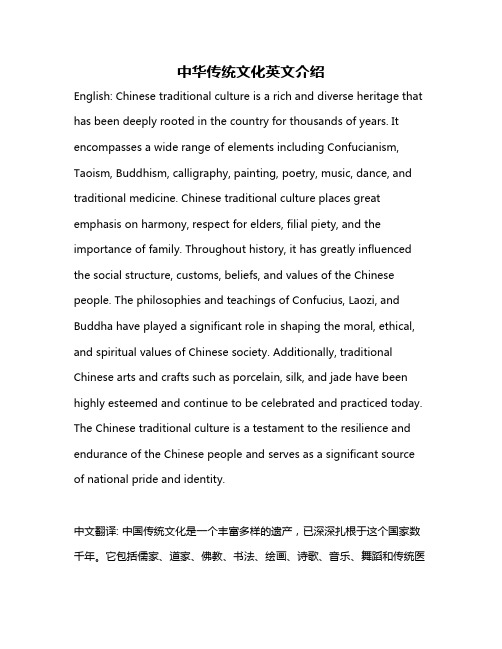
中华传统文化英文介绍English: Chinese traditional culture is a rich and diverse heritage that has been deeply rooted in the country for thousands of years. It encompasses a wide range of elements including Confucianism, Taoism, Buddhism, calligraphy, painting, poetry, music, dance, and traditional medicine. Chinese traditional culture places great emphasis on harmony, respect for elders, filial piety, and the importance of family. Throughout history, it has greatly influenced the social structure, customs, beliefs, and values of the Chinese people. The philosophies and teachings of Confucius, Laozi, and Buddha have played a significant role in shaping the moral, ethical, and spiritual values of Chinese society. Additionally, traditional Chinese arts and crafts such as porcelain, silk, and jade have been highly esteemed and continue to be celebrated and practiced today. The Chinese traditional culture is a testament to the resilience and endurance of the Chinese people and serves as a significant source of national pride and identity.中文翻译: 中国传统文化是一个丰富多样的遗产,已深深扎根于这个国家数千年。
高中英语 高考英语作文有关中国传统文化的范文5篇带中文翻译
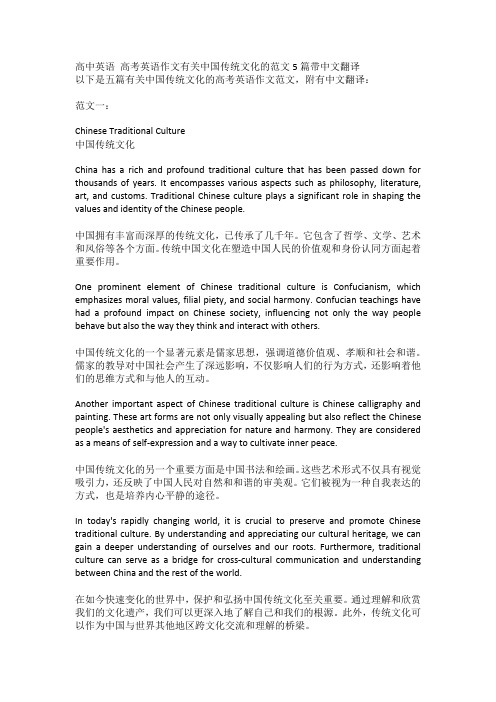
高中英语高考英语作文有关中国传统文化的范文5篇带中文翻译以下是五篇有关中国传统文化的高考英语作文范文,附有中文翻译:范文一:Chinese Traditional Culture中国传统文化China has a rich and profound traditional culture that has been passed down for thousands of years. It encompasses various aspects such as philosophy, literature, art, and customs. Traditional Chinese culture plays a significant role in shaping the values and identity of the Chinese people.中国拥有丰富而深厚的传统文化,已传承了几千年。
它包含了哲学、文学、艺术和风俗等各个方面。
传统中国文化在塑造中国人民的价值观和身份认同方面起着重要作用。
One prominent element of Chinese traditional culture is Confucianism, which emphasizes moral values, filial piety, and social harmony. Confucian teachings have had a profound impact on Chinese society, influencing not only the way people behave but also the way they think and interact with others.中国传统文化的一个显著元素是儒家思想,强调道德价值观、孝顺和社会和谐。
儒家的教导对中国社会产生了深远影响,不仅影响人们的行为方式,还影响着他们的思维方式和与他人的互动。
中国传统文化介绍(英文版)
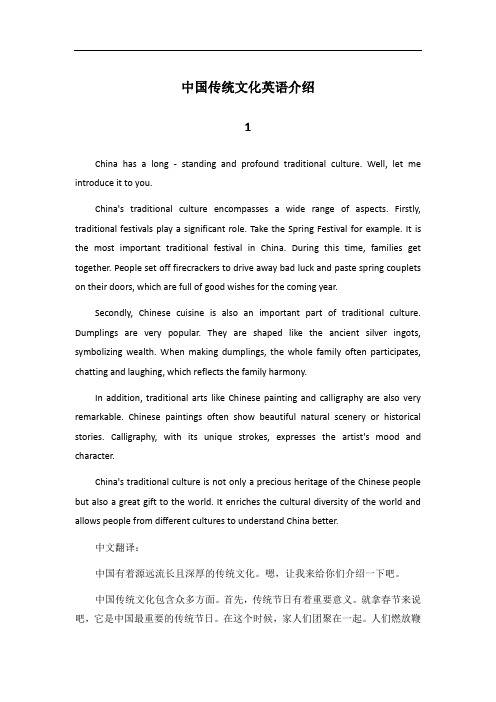
中国传统文化英语介绍1China has a long -standing and profound traditional culture. Well, let me introduce it to you.China's traditional culture encompasses a wide range of aspects. Firstly, traditional festivals play a significant role. Take the Spring Festival for example. It is the most important traditional festival in China. During this time, families get together. People set off firecrackers to drive away bad luck and paste spring couplets on their doors, which are full of good wishes for the coming year.Secondly, Chinese cuisine is also an important part of traditional culture. Dumplings are very popular. They are shaped like the ancient silver ingots, symbolizing wealth. When making dumplings, the whole family often participates, chatting and laughing, which reflects the family harmony.In addition, traditional arts like Chinese painting and calligraphy are also very remarkable. Chinese paintings often show beautiful natural scenery or historical stories. Calligraphy, with its unique strokes, expresses the artist's mood and character.China's traditional culture is not only a precious heritage of the Chinese people but also a great gift to the world. It enriches the cultural diversity of the world and allows people from different cultures to understand China better.中文翻译:中国有着源远流长且深厚的传统文化。
中国传统文化 翻译
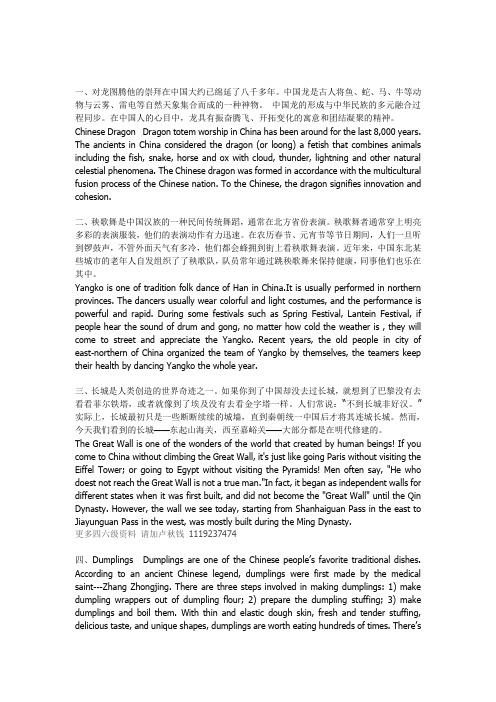
一、对龙图腾他的崇拜在中国大约已绵延了八千多年。
中国龙是古人将鱼、蛇、马、牛等动物与云雾、雷电等自然天象集合而成的一种神物。
中国龙的形成与中华民族的多元融合过程同步。
在中国人的心目中,龙具有振奋腾飞、开拓变化的寓意和团结凝聚的精神。
Chinese Dragon Dragon totem worship in China has been around for the last 8,000 years. The ancients in China considered the dragon (or loong) a fetish that combines animals including the fish, snake, horse and ox with cloud, thunder, lightning and other natural celestial phenomena. The Chinese dragon was formed in accordance with the multicultural fusion process of the Chinese nation. To the Chinese, the dragon signifies innovation and cohesion.二、秧歌舞是中国汉族的一种民间传统舞蹈,通常在北方省份表演。
秧歌舞者通常穿上明亮多彩的表演服装,他们的表演动作有力迅速。
在农历春节、元宵节等节日期间,人们一旦听到锣鼓声,不管外面天气有多冷,他们都会蜂拥到街上看秧歌舞表演。
近年来,中国东北某些城市的老年人自发组织了了秧歌队,队员常年通过跳秧歌舞来保持健康,同事他们也乐在其中。
Yangko is one of tradition folk dance of Han in China.It is usually performed in northern provinces. The dancers usually wear colorful and light costumes, and the performance is powerful and rapid. During some festivals such as Spring Festival, Lantein Festival, if people hear the sound of drum and gong, no matter how cold the weather is , they will come to street and appreciate the Yangko. Recent years, the old people in city of east-northern of China organized the team of Yangko by themselves, the teamers keep their health by dancing Yangko the whole year.三、长城是人类创造的世界奇迹之一。
中华优秀传统文化英文解读课文翻译unit7textA

中华优秀传统文化英文解读课文翻译unit7textA 第七课:文化遗迹SPEAKINGYour job is to make a culture capsule.你的工作是做一个文化舱。
This capsule is a large box (about2×2 metres).这个舱是一个大箱子(约2×2 m)。
It will be sent into space so that anyone who finds it will understand who we are.它将被发射进入太空,这样发现它的人就知道我们是谁了。
Work in pairs to prepare a “Chinese Culture Capsule”.两个人一组准备一个“中国文化舱”。
You can select five things that represent Chinese culture,你可以选五件象征中国文化的东西,but you cannot put any living things in the capsule.但不得在舱里放置任何生物。
You may also include a short message (two sentences) in any language in the box,你还可以在箱子上用任何一种语言写一封短信(两个句子),but remember that those who find the capsule may not understand your language.但记住:发现这个舱的人也许不懂你的语言。
A CITY OF HEROES英雄之城Where there is a river, there is a city.哪里有河流,哪里就有城市。
Perhaps this is not always true,或许并不总是这样,but it is true that many of the world’s greatest cities have been built on the banks of a river.但世界上很多最伟大的城市确实是建在河流两岸的。
中国传统文化特色词语汉维翻译
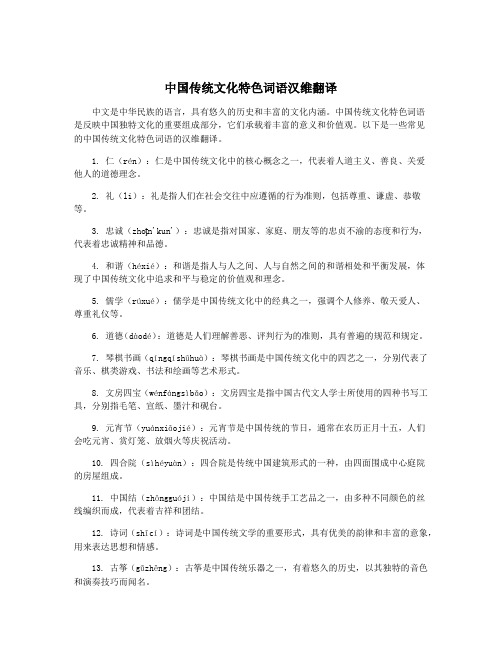
中国传统文化特色词语汉维翻译中文是中华民族的语言,具有悠久的历史和丰富的文化内涵。
中国传统文化特色词语是反映中国独特文化的重要组成部分,它们承载着丰富的意义和价值观。
以下是一些常见的中国传统文化特色词语的汉维翻译。
1. 仁(rén):仁是中国传统文化中的核心概念之一,代表着人道主义、善良、关爱他人的道德理念。
2. 礼(li):礼是指人们在社会交往中应遵循的行为准则,包括尊重、谦虚、恭敬等。
3. 忠诚(zhoțn'kun'):忠诚是指对国家、家庭、朋友等的忠贞不渝的态度和行为,代表着忠诚精神和品德。
4. 和谐(héxié):和谐是指人与人之间、人与自然之间的和谐相处和平衡发展,体现了中国传统文化中追求和平与稳定的价值观和理念。
5. 儒学(rúxué):儒学是中国传统文化中的经典之一,强调个人修养、敬天爱人、尊重礼仪等。
6. 道德(dàodé):道德是人们理解善恶、评判行为的准则,具有普遍的规范和规定。
7. 琴棋书画(qíngqíshūhuà):琴棋书画是中国传统文化中的四艺之一,分别代表了音乐、棋类游戏、书法和绘画等艺术形式。
8. 文房四宝(wénfángsìbǎo):文房四宝是指中国古代文人学士所使用的四种书写工具,分别指毛笔、宣纸、墨汁和砚台。
9. 元宵节(yuánxiāojié):元宵节是中国传统的节日,通常在农历正月十五,人们会吃元宵、赏灯笼、放烟火等庆祝活动。
10. 四合院(sìhéyuàn):四合院是传统中国建筑形式的一种,由四面围成中心庭院的房屋组成。
11. 中国结(zhōngguójí):中国结是中国传统手工艺品之一,由多种不同颜色的丝线编织而成,代表着吉祥和团结。
12. 诗词(shīcí):诗词是中国传统文学的重要形式,具有优美的韵律和丰富的意象,用来表达思想和情感。
中国传统文化中英对照
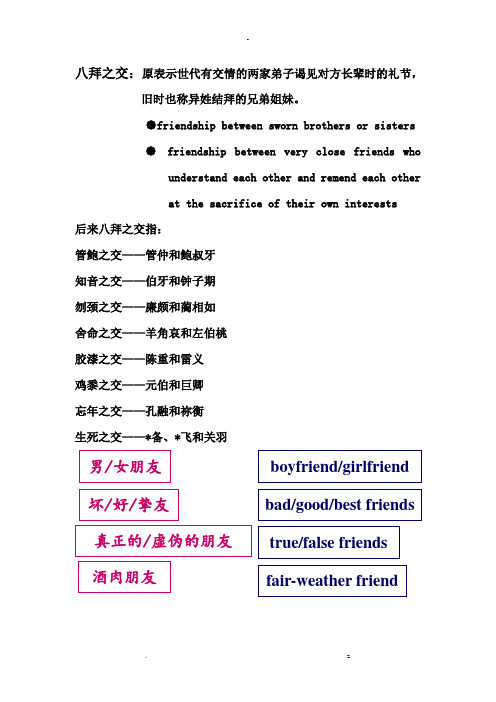
八拜之交:原表示世代有交情的两家弟子谒见对方长辈时的礼节,旧时也称异姓结拜的兄弟姐妹。
●friendship between sworn brothers or sisters●friendship between very close friends whounderstand each other and remend each otherat the sacrifice of their own interests莫逆之交:bosom friends总角之交:friendship between people who are friends since childhood一般作宾语,指儿时的朋友。
总角:古代未成年的人把头发扎成髻。
借指童年时期,幼年。
总角是八九岁至十三四岁的少年,古代儿童将头发分作左右两半,在头顶各扎成一个结,形如两个羊角,故称“总角〞。
贫贱之交:friendship between people who are poverty-stricken and from humble circumstances杵臼之交:friendship between people who do not care about the financial condition and social status of each other 杵:舂米的木棒;臼:石臼。
比喻交朋友不计较贫富和身分。
君子之交:friendship between gentlemen小人之交:friendship between villains狐朋狗友:people who often gather together doing something meaningless and even illegal棋友/牌友/球友:people who often meet to play chess, poker, ball. etc.战友:people who get to know each other while serving in the same army unit普通老百姓交的朋友谓“布衣之交〞;有钱人与没钱人交朋友谓“车笠之交〞;在逆境中结交的朋友称“患难之交〞;吃喝玩乐结交的朋友称“酒肉之交〞;年岁差异大,行辈不同而交情深厚的朋友称“忘年之交〞;幼年相交的朋友称“竹马之交〞;交情深厚的朋友谓“肺腑之交〞;亲密无间的朋友谓“胶漆之交〞;生死与共的朋友谓“生死之交〞;情投意合的朋友称“莫逆之交〞;哪怕砍头也不改变友谊的朋友称“刎颈之交〞;无意中相遇而结成的朋友称“邂逅之交〞;在道义上互相支持的朋友称“君子之交〞;只见过一次面,交情不深的朋友称“一面之交〞;仅点头打招呼,感情不深的朋友称“点头之交〞;平淡而浮泛交往的朋友称“泛泛之交〞;见过面但不熟悉的人称“半面之交〞;旧时结拜的兄弟姊妹称“八拜之交〞;交友不嫌贫贱称“杵逆之交〞;珍贵而有价值的交往称“金玉之交〞。
中国传统文化词汇翻译解读

口译分类词汇——中国文化概述General Terms爱国主义精神patriotism诚实守信honesty公民道德建设实施纲要The Program for Improving Civic Morality集体主义collectivism弘扬主旋律,提倡多样化highlight the central theme of the times while encouraging diversity 全民健身运动nationwide fitness campaign社会公德,职业道德和家庭美德教育education in social and professional ethics and family virtues为人民服务serving the people深入群众,深入生活go deep among the masses and into the thick of life奉献无愧于时代的作品contribute to the people works worthy of the times中华文明博大精深,源远流长The Chinese civilization is extensive and profound , and has a long history重要文化遗产major cultural heritage优秀民间艺术outstanding folk arts自立于世界民族之林stand proudly in the family of nations艺术及工艺Arts and Crafts版画engraving贝雕画shell carving picture彩塑painted sculpture瓷器porcelain; china刺绣embroidery雕刻carving宫灯palace lantern国画Chinese painting剪纸paper-cut景德镇瓷Jingdezhen porcelainenamel景泰蓝cloisonné蜡染batik卖秸画straw patchwork木/石/竹刻wood/stone/bamboo carving木刻画wood engraving泥人儿clay figure皮影shadow puppet漆画lacquer painting漆器lacquer ware双面绣two-sided embroidery水墨画Chinese brush drawing ; ink and wash painting檀香扇sandalwood fan唐三彩Tang tri-colored pottery陶器pottery ; earthenware图章seal拓碑making rubbings from inscriptions , pictures , etc . on stone tablets 拓片rubbing微雕miniature engraving象牙雕刻ivory carving宜兴陶Yixing pottery篆刻seal cutting戏剧表演Theatrical Performances京剧人物脸谱types of facial makeup in Beijing opera生male characters末middle-aged male characters净“painted face” characters旦female characters丑clown京剧票友amateur performer of Peking Opera木偶戏puppet show独角戏monodrama; one-man play皮影戏shadow play ; leather-silhouette show折子戏opera highlights戏剧小品skit哑剧dumb show ; mime ; mummery ; pantomime单口相声monologue comic talk双口相声witty dialogue口技vocal imitations ; ventriloquism说书monologue story-telling杂技acrobatic performance叠罗汉making a human pyramid特技stunt睬高跷stilt walk马戏circus performances神话人物Mythological Figures八仙the Eight Immortals嫦娥Chang’s ( the Chinese moon goddess)伏羲Fu Xi (God of Fishery and Husbandry)福禄寿三星the three gods of fortune , prosperity and longevity 共工God of Water后羿Houyi (a legendary hero who shot down nine suns ) 黄帝Yellow Emperor夸父Kuafu (a fabled sun-chasing giant )女Goddess of Sky-patching盘古Pan Gu (creator of the universe )神农Patron of Agriculture禹Yu ( the reputed founder of the Xia Dynasty )祝融God of Fire古代建筑Ancient Architecture塔pagoda琉璃塔glazed stupa舍利塔dagoba ; sarira stupa ( a pagoda for Buddhist relics )舍利子sarira remains from cremation of Buddha’s of saints’ body喇叭塔Lamaist pagoda楼storied buildings钟楼bell tower鼓楼drum tower阁pavilion烽火台beacon tower华表ornamental column牌坊memorial archway传统节日Traditional Festivals拜年paying a New Year call爆竹firecracker鞭炮 a string of small firecrackers除夕New Year’s Eve春节Spring Festival春联Spring Festival couplets (conveying best wishes for the year )辞旧迎新bid farewell to the old and usher in the new ; ring out the old year and ring in the new大扫除year-end household cleaning灯谜lantern riddles登高hill climbing端午节Dragon Boat Festival恭喜发财May you be prosperous! / Wish you all the best !观灯viewing the lanterns贺年片New Year film饺子dumplings (with meat and vegetable stuffing )龙灯舞dragon lantern dance庙会temple fair年画New Year picture年夜饭family reunion dinner on Lunar New Year’s Eve清明节Tomb-sweeping Festival扫墓paying respect to the dead赏菊enjoying chrysanthemum赏月enjoying the full moon狮子舞lion dance压岁钱money given to children as a Lunar New Year gift秧歌舞yangge dance元宵sweet rice-flour dumplings (eaten on the Lantern Festival )元宵节Lantern Festival月饼moon cake植树节Tree-planting Day中秋节Mid-autumn Festival重阳节Double Ninth Festival粽子 a pyramid-shaped dumpling made of glutinous rice wrapped in bamboo or reed leaves烹饪Culinary Arts美食节gourmet festival中餐烹饪Chinese cuisine色,香,味俱全perfect combination of color , aroma , taste and appearance四大菜系:山东菜,四川菜,粤菜,扬州菜four major Chinese cuisines: Shandong cuisine , Sichuan cuisine , Canton cuisine and Yangzhou cuisine南淡北咸,东甜西辣the light southern cuisine , and the salty northern cuisine ;the sweet eastern cuisine , and the spicy western cuisine八宝菜eight-treasure pickles ( assorted walnut meats , asparagus , lettuce , almonds , cucumber and peanuts , etc . pickled in soy sauce )八宝饭eight-treasure rice pudding (glutinous rice steamed with preserved fruits , sweetened bean paste , lotus seeds , longan , etc.)白斩鸡tender boiled chicken (made by boiling a whole chicken in water and cutting into cubes , then dipping into seasonings )臭豆腐odd-odour bean curb粉蒸肉pork streamed with rice flour风味小吃local delicacy腐竹rolls of dried bean milk cream冷盘hors d’oeuvres萨其马Manchu candied fritter cut in squares刀切,火候Cutting and Slicing Techniques , Heat Control切片slicing切条cutting to strips切丝shredding切柳filleting切丁dicing切碎mincing磨碎grinding大/旺/武火strong heat中火medium heat小/微/文火gentle heat烹饪方法Cooking Techniques煎pan-frying炒stir-frying爆quick-frying炸deep-frying烩stewing熏smoking煨simmering煮boiling烘baking烤roasting蒸steaming红烧braising (with soy sauce )涮羊肉dip-boiled mutton slices羊肉串小摊mutton barbecue stall宗教Religions佛教Buddhism释迦牟尼Sakyamuni佛寺Buddhist temple大雄宝殿the Great Buddha’s Hall藏经楼depositary of Buddhist texts金刚经Vajracchedika-sutra素菜馆vegetarian restaurant罗汉堂arhat hall观音Guanyin; Goddess of Mercy; Avalokitesvara地藏God of Earth四大金刚Four Heavenly Guardians (at the entrance to a Buddhism temple);Four Devarajas四大天王Four Heavenly Kings因果报应karma藏传佛教Lamaism大藏经Tripitaka转世灵童reincarnated soul boy喇嘛庙lamasery道教Taoism道观Taoist temple道士Taoist priest关帝庙temple of Lord Guan儒教Confucianism孔子庙Confucian temple孔子Confucius义,礼,智,信,忠,恕,孝,悌rightness, propriety , wisdom , trustworthiness , loyalty , reciprocity ,filial piety , brotherly love学儿优则仕 A good scholar can become an official ./ He who excels in study can follow an official career .禅宗Zen Buddhism不立别传,不立文字,直指人心,见性成佛。
传统中国文化八大主题中英翻译-
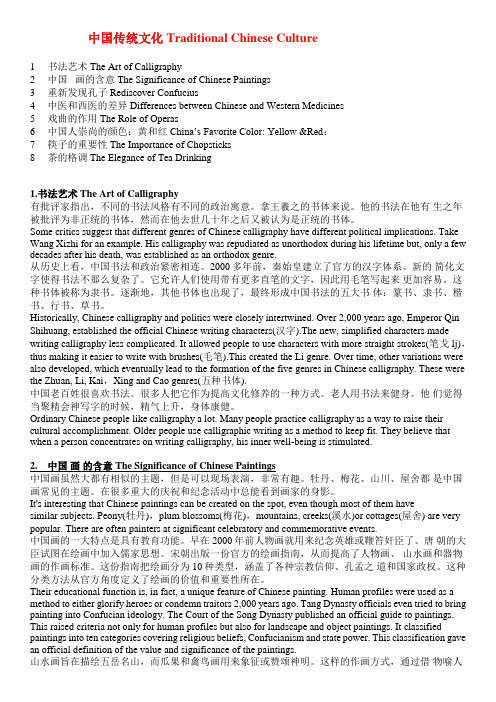
中国传统文化 Traditional Chinese Culture1 书法艺术 The Art of Calligraphy2 中国 _画的含意 The Significance of Chinese Paintings3 重新发现孔子 Rediscover Confucius4 中医和西医的差异 Differences between Chinese and Western Medicines5 戏曲的作用 The Role of Operas6 中国人崇尚的颜色:黄和红China’s Favorite Color: Yellow &Red:7 筷子的重要性 The Importance of Chopsticks8 茶的格调 The Elegance of Tea Drinking1.书法艺术 The Art of Calligraphy有批评家指出,不同的书法风格有不同的政治寓意。
拿王羲之的书体来说。
他的书法在他有生之年被批评为非正统的书体,然而在他去世几十年之后又被认为是正统的书体。
Some critics suggest that different genres of Chinese calligraphy have different political implications. Take Wang Xizhi for an example. His calligraphy was repudiated as unorthodox during his lifetime but, only a few decades after his death, was established as an orthodox genre.从历史上看,中国书法和政治紧密相连。
2000多年前,秦始皇建立了官方的汉字体系。
新的简化文字使得书法不那么复杂了。
它允许人们使用带有更多直笔的文字,因此用毛笔写起来更加容易。
传统文化英文解读课本
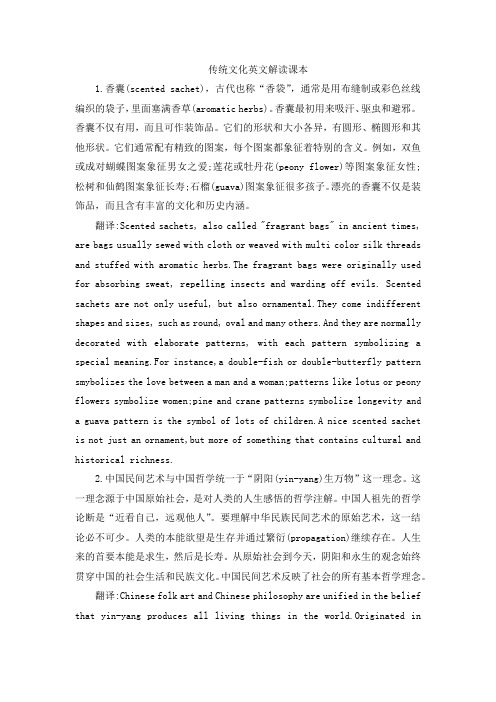
传统文化英文解读课本1.香囊(scented sachet),古代也称“香袋”,通常是用布缝制或彩色丝线编织的袋子,里面塞满香草(aromatic herbs)。
香囊最初用来吸汗、驱虫和避邪。
香囊不仅有用,而且可作装饰品。
它们的形状和大小各异,有圆形、椭圆形和其他形状。
它们通常配有精致的图案,每个图案都象征着特别的含义。
例如,双鱼或成对蝴蝶图案象征男女之爱;莲花或牡丹花(peony flower)等图案象征女性;松树和仙鹤图案象征长寿;石榴(guava)图案象征很多孩子。
漂亮的香囊不仅是装饰品,而且含有丰富的文化和历史内涵。
翻译:Scented sachets, also called "fragrant bags" in ancient times, are bags usually sewed with cloth or weaved with multi color silk threads and stuffed with aromatic herbs.The fragrant bags were originally used for absorbing sweat, repelling insects and warding off evils. Scented sachets are not only useful, but also ornamental.They come indifferent shapes and sizes, such as round, oval and many others.And they are normally decorated with elaborate patterns, with each pattern symbolizing a special meaning.For instance,a double-fish or double-butterfly pattern smybolizes the love between a man and a woman;patterns like lotus or peony flowers symbolize women;pine and crane patterns symbolize longevity and a guava pattern is the symbol of lots of children.A nice scented sachet is not just an ornament,but more of something that contains cultural and historical richness.2.中国民间艺术与中国哲学统一于“阴阳(yin-yang)生万物”这一理念。
- 1、下载文档前请自行甄别文档内容的完整性,平台不提供额外的编辑、内容补充、找答案等附加服务。
- 2、"仅部分预览"的文档,不可在线预览部分如存在完整性等问题,可反馈申请退款(可完整预览的文档不适用该条件!)。
- 3、如文档侵犯您的权益,请联系客服反馈,我们会尽快为您处理(人工客服工作时间:9:00-18:30)。
1. 元宵节:Lantern Festival2. 刺绣:embroidery3. 重阳节:Double-Ninth Festival4. 清明节:Tomb sweeping day5. 剪纸:Paper Cutting6. 书法:Calligraphy7. 对联:(Spring Festival) Couplets8. 象形文字:Pictograms/Pictographic Characters9. 人才流动:Brain Drain/Brain Flow10. 四合院:Siheyuan/Quadrangle11. 战国:Warring States12. 风水:Fengshui/Geomantic Omen13. 铁饭碗:Iron Bowl14. 函授部:The Correspondence Department15. 集体舞:Group Dance16. 黄土高原:Loess Plateau17. 红白喜事:Weddings and Funerals18. 中秋节:Mid-Autumn Day19. 结婚证:Marriage Certificate20. 儒家文化:Confucian Culture21. 附属学校:Affiliated school22. 古装片:Costume Drama23. 武打片:Chinese Swordplay Movie24. 元宵:Tangyuan/Sweet Rice Dumpling (Soup)25. 一国两制:One Country, Two Systems26. 火锅:Hot Pot27. 四人帮:Gang of Four28. 《诗经》:The Book of Songs29. 素质教育:Essential-qualities-oriented Education30. 《史记》:Historical Records/Records of the Grand Historian31. 大跃进:Great Leap Forward (Movement)32. 《西游记》:The Journey to the West33. 除夕:Chinese New Year’s Eve/Eve of the Spring Festival34. 针灸:Acupuncture35. 唐三彩:Tri-color Pottery of the Tang Dynasty/ The Tang Tri-colored pottery36. 中国特色的社会主义:Chinese-charactered Socialist/Socialist with Chinese characteristics37. 偏旁:radical38. 孟子:Mencius39. 亭/阁:Pavilion/ Attic40. 大中型国有企业:Large and Medium-sized State-owned Enterprises41. 火药:gunpowder42. 农历:Lunar Calendar43. 印/玺:Seal/Stamp44. 物质精神文明建设:The Construction of Material Civilization and Spiritual Civilization45. 京剧:Beijing Opera/Peking Opera46. 秦腔:Crying of Qin People/Qin Opera47. 太极拳:Tai Chi48. 独生子女证:The Certificate of One-child49. 天坛:Altar of Heaven in Beijing50. 小吃摊:Snack Bar/Snack Stand51. 红双喜:Double Happiness52. 政治辅导员:Political Counselor/School Counselor53. 春卷:Spring Roll(s)54. 莲藕:Lotus Root55. 追星族:Star Struck56. 故宫博物院:The Palace Museum57. 相声:Cross-talk/Comic Dialogue58. 下岗:Lay off/Laid off59. 北京烤鸭:Beijing Roast Duck60. 高等自学考试:Self-taught Examination of Higher Education61. 烟花爆竹:fireworks and firecracker62. 敦煌莫高窟:Mogao Caves63. 电视小品:TV Sketch/TV Skit64. 香港澳门同胞:Compatriots from Hong Kong and Macao65. 文化大革命:Cultural Revolution66. 长江中下游地区:The Mid-low Reaches of Yangtze River67. 门当户对:Perfect Match/Exact Match68. 《水浒》:Water Margin/Outlaws of the Marsh69. 中外合资企业:Joint Ventures70. 文房四宝(笔墨纸砚):"The Four Treasure of the Study" "Brush, Inkstick, Paper, and Inkstone"71.兵马俑:cotta Warriors/ Terracotta Army72.旗袍:cheongsam要了解中国文化,就应该对中国的戏曲文化有所了解。
中国地方戏种类很多,其中京剧是一个具有代表性的剧种。
作为一个独立的剧种,京剧的诞生大约是在1840年至l860 。
京剧是在吸收其他地方戏营养的基础上形成的。
京剧有明确的角色分工;在念白上用北京方言;在音乐上以胡琴为主要伴奏乐器。
由于京剧是在融合各种地方戏之精华的基础上形成的,所以它不仅为北京的观众所钟爱,也受到全国人民的喜爱。
中国是世界上最大的发展中国家,人口约占世界总人口的22%。
在过去相当长的时期里,由于诸多原因,贫困一直困扰着中国。
20世纪80年代中期,中国农村绝大多数地区凭借自身的发展优势,经济得到快速增长,但少数地区由于经济、社会、历史、自然等方面的制约,发展相对滞后。
中国政府在致力于经济和社会全面发展的进程中,在全国范围内实施了以解决贫困人口温饱问题为主要目标的有计划、有组织的大规模扶贫开发,极大地缓解了贫困现象。
中国新年是中国最重要的传统节日,在中国也被称为春节。
新年的庆祝活动从除夕开始一直延续到元宵节(the Lantern Festival),即从农历(lunlar calendar)最后一个月的最后一天至新年第一个月的第十五天。
各地欢度春节的习俗和传统有很大差异,但通常每个家庭都会在除夕夜团聚,一起吃年夜饭。
为驱厄运、迎好运,家家户户都会进行大扫除。
人们还会在门上粘贴红色的对联(couplets),对联的主题为健康、发财和好运、其他的活动还有放鞭炮、发红包和探亲访友等。
北京有无数的胡同(hutong)。
平民百姓在胡同里的生活给古都北京带来了无穷的魅力。
北京的胡同不仅仅是平民百姓的生活环境,而且还是一门建筑艺术。
通常,胡同内有一个大杂院,房间够4到10个家庭的差不多20 口人住。
所以,胡同里的生活充满了友善和人情味。
如今,随着社会和经济的飞速发展,很多胡同被新的高楼大厦所取代。
但愿胡同可以保留下来。
In Beijing, there are numerous hutongs. The life of common people in hutongs brings endless charm to the ancient capital, Beijing. The hutong in Beijing is not only the living environment of common people but also a kind of architecture. Usually, there is a courtyard complex inside hutong, with rooms shared by 4 to 10 families of about 20 people. Therefore, life in hutongs is full of friendliness and genuine humanity. Nowadays, with rapid social and economic development, many hutongs are replaced by new tall buildings. I hope hutongs can be preserved.中欧经济贸易合作取得了可喜的成果。
欧盟巳经成为中国的重要经贸伙伴,是中国最大的技术供应方、第三大贸易伙伴和第五大实际投资方。
2001年,中欧贸易达到766亿美元,比上一年增长11%,尤其是中国从欧盟的进口增长了15.8%。
我非常赞赏欧中贸协(Europe-China Business Association)与比中经贸理事会(Belgium-Chinese Economic and Commercial Council)为发展中欧关系所做出的努力。
中欧经济贸易合作具有广阔的前景。
中欧经济具有很强的互补性,在贸易、投资、科技等领域具有很大的合作潜力。
China-EU economic and trade cooperation has yielded heartening fruits. The EU has now become an important economic and trade partner of China, working as the largest technology supplier, the third largest trading partner and the fifth largest actual investor in China. Bilateral trade reached 76.6 billion dollars in 2001, achieving an 11% increase compared to the previous year. In particular, China’s imports from the EU grew by 15.8%. I highly appreciate the efforts by the Europe-China Business Association and the Belgium-Chinese Economic and Commercial Council for developing China-EU ties. China-EU trade and economic cooperation is endowed with a promising future. The two economies are strongly complimentary to each other and hence enjoy huge potential for cooperation in trade, investment, science and technology areas中医(Traditional Chinese Medicine)是中华文化不可分割的一部分,为振兴华夏做出了巨大的贡献。
